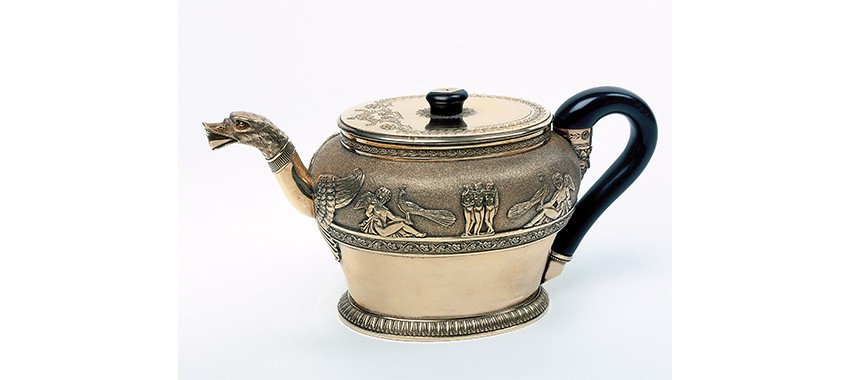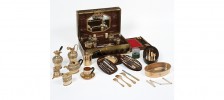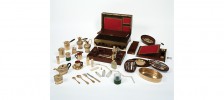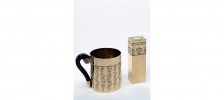Duchess of Otranto’s Necessaire
Martin-Guillaume Biennais (1764-1843)
“Nécessaire” belonging to the Duchess of Otranto
1815
Mahogany, gilt silver, ebony, gold, ivory, crystal, mother-of-pearl, morocco leather, brass, gilt bronze
Signed on the lock: “Biennais Orfre rue St Honoré n°283 Au Singe Violet à Paris”
Chest: H. 16 ; W. 40 ; D. 30 cm
Inv. 566, donation Lapeyre
On 1 August 1815, Joseph Fouché, Duke of Otranto (1759-1820), took as his second wife Ernestine de Castellane (1788-1850), a pretty young lady from Provence who was thirty years his junior. The jewel in the crown of the wedding presents was a masterpiece signed by Biennais, a “nécessaire de voyage”, or travel case, from under the famous sign of the “Singe Violet” (purple monkey), a miniature marvel of the cabinet-maker’s and goldsmith’s art testifying to a remarkable event in the history of France: the marriage of Fouché, the all-powerful Minister of the Police, former Jacobin and regicide, with a member of the Castellane family, one of the finest names in the armorial of Provence.
Maker of fine small-scale items such as table games, cabinet-maker and goldsmith, and official purveyor to the imperial court, Biennais had made these “nécessaires” his speciality: small portable chests hollowed out of a single piece of rare wood containing the maximum number of articles in the minimum amount of space. Napoléonpossessed several large travel chests in vermeil or in silver. It was therefore a matter of course that Fouché should commission this luxurious wedding gift from the virtuoso of the genre.
The Duchess of Otranto’s “nécessaire” is an immensely sophisticated piece of work, comprising 75 different items ingeniously fitted into a chest hollowed out of mahogany, bearing on its lid the monogram CF beneath a ducal crown surrounded by laurels. Besides the dozens of utensils necessary for washing and writing, the chest also contains a tea and coffee service in chased vermeil engraved with antique style ornamentation and mythological scenes evoking the hymen.
A description of the contents is surprising, given the dimensions of the chest: teapot; coffee pot; chocolate pot; portable stove; tea caddy; two cups and saucers; matching ewer and basin; three boxes, two of which have a false bottom; glass; two cutlery place settings; two coffee spoons; four knives; three ointment pots; four ivory boxes; seven crystal flasks; two salt cellars; two ivory brushes; two pocket knives; three pairs of scissors; a pair of tongs; a collection of items to do with dental hygiene including a toothbrush; a set of sewing equipment, including an enamelled gold thimble and a folding tape-measure in gold inlaid with mother-of-pearl; a pen case; a compass; etc. A side drawer even houses a portable desktop complete with inkwell and blotter. Finally, the inside of the lid features an octagonal mirror, behind which is a set of portfolios in red and green morocco leather with gilt tooling.
Photographs © Fondation Napoléon- Patrice Maurin-Berthier














